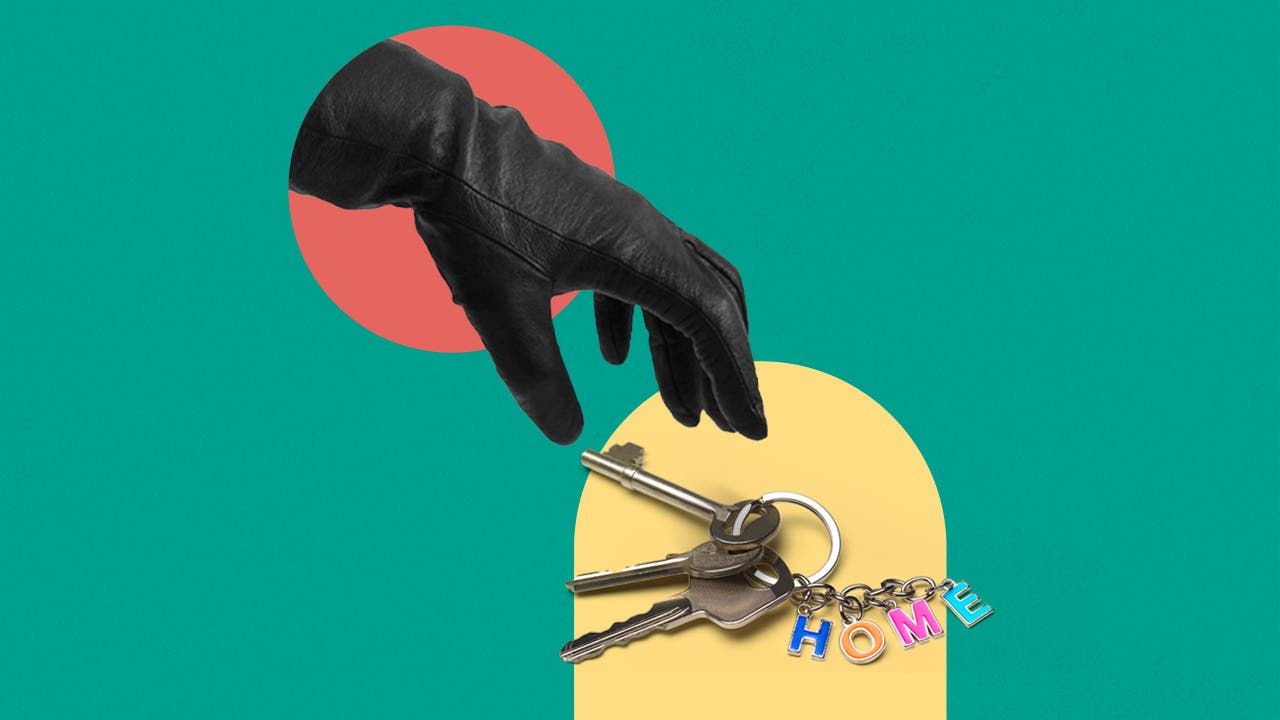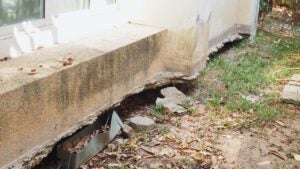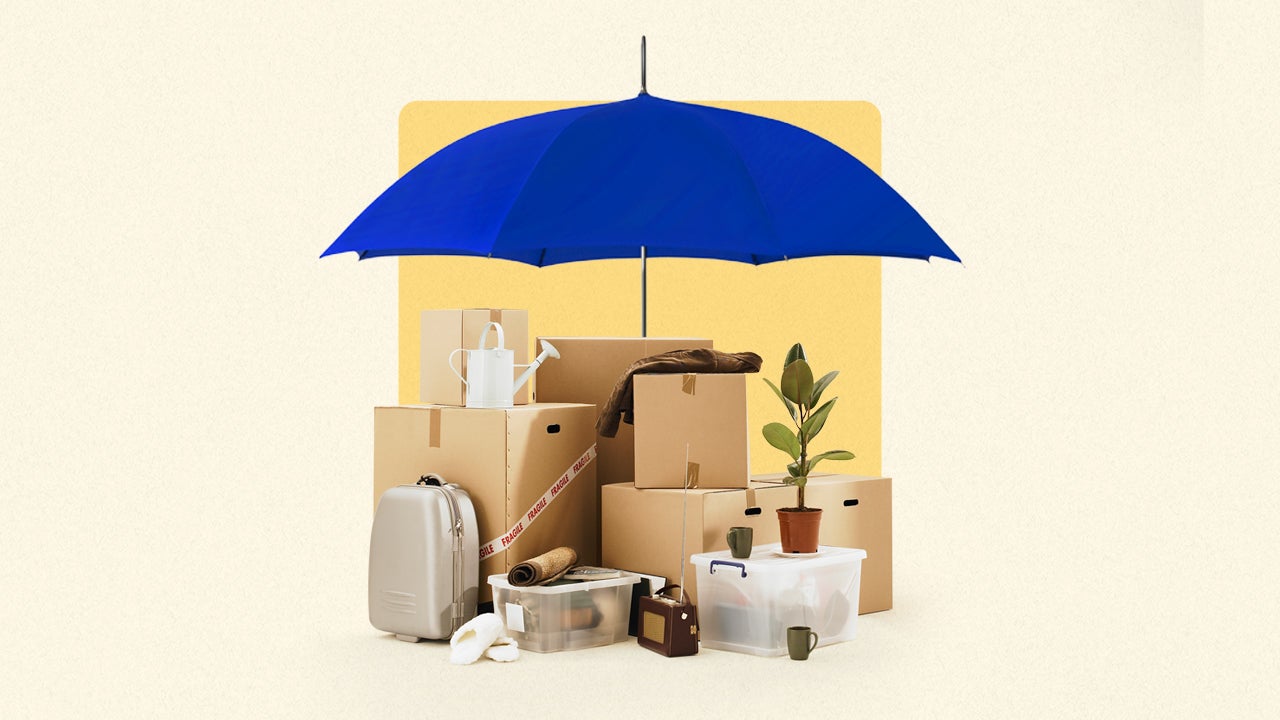Does homeowners insurance cover theft?

Key takeaways
- Home insurance policies generally cover theft, including theft damage to the home and theft that occurs away from home.
- For high-value or antique items, homeowners may need scheduled personal property coverage, as standard policies may not fully cover all valuables.
- The payout for stolen items depends on whether the policy is an actual cash value or replacement cost policy. The former takes depreciation into account, while the latter pays the cost to replace items at current prices.
If you come home to find your property stolen or destroyed, your first move should be to call the authorities to file a police report. Next, you’ll likely want to file a claim with your home insurance company. Home insurance does cover theft in many cases, but there are some specifics to keep in mind before you call your insurance agent to start the claims process. Bankrate’s insurance editorial team has done the legwork to help you understand the finer points of your home insurance coverage as it relates to theft and burglary.
Does home insurance cover theft?
Most homeowners insurance policies cover theft. If you have an HO-3 policy — the most common type of homeowners insurance — you have theft insurance; theft is one of the named perils included in standard coverage. However, most home insurance policies have a vacancy clause that voids theft coverage. If your property has been vacant for more than 60 consecutive days, you may not be able to file a claim for theft.
In an insurance contract, vacant and unoccupied mean two different things: a vacant property has no belongings or people living in it, while an unoccupied property only lacks people. For example, when you go on vacation, your home is considered unoccupied because all of your furniture and personal belongings are still there.
Coverage for theft of personal property in your home
If your personal belongings are stolen from your home, you can file an insurance claim for the property loss. Your personal property is covered under Coverage C of your home insurance policy, which is usually between 50 and 70 percent of your total dwelling limit. So, if you have a $300K dwelling limit, you likely have anywhere from $150K to $210K in personal property insurance. This also applies to valuable items, but only up to your policy’s limits and sublimits.
Coverage for damage from theft
A burglar may smash windows, break down doors and destroy locks in order to enter your home. Damage to your home’s physical structure is typically covered under Coverage A dwelling insurance. You can check your insurance declarations page to verify how much dwelling coverage you have.
Coverage for theft from detached structures
Like your home, detached structures on your property are also financially protected from theft. Other structures on your property, like a shed or detached garage, are covered under Coverage B for up to 10 percent of your total dwelling limit. This includes damage to the structure itself, but belongings stored in a detached structure are covered under the personal property part of your policy.
Coverage for theft of personal property off-premises
Your home insurance policy can also protect you from theft outside of the home, like when you’re out and about or traveling. In most cases, personal property outside the home is covered up to 10 percent of your Coverage C limit or $1,000, whichever is higher.
How to file a home insurance claim for theft
If you’ve been the victim of theft and the damages are greater than your deductible, you might want to file a home insurance claim. This allows your insurance provider to investigate your loss and potentially pay you for your damages. You can file a claim by following these steps:
- Assess and document the damage. If your home or car has been broken into, take stock of what was damaged. Damage to your car should be covered by a full coverage auto insurance policy, whereas damage to your home and any stolen property (from your home or car) should be covered by your home insurance. You don’t have to work up an exact dollar amount for the car or home damage and stolen items, but you’ll probably want to make sure the damage is above your deductible before you file a claim. Obtaining a police report and taking photos can also be helpful.
- Contact your insurance company. Many companies have mobile apps that allow you to file a claim or access online customer portals. You might need to call an 800-number or talk to your local agent to initiate the claims process. You’ll need the date the loss happened, details about the event and information about the damage that occurred.
- Work with your claim representative. Your case will likely be handled by a claim representative, although occasionally you’ll work with an entire team of claim handlers. These insurance representatives are called adjusters. Keep in contact with your adjuster via email, phone, text or mail. You may need to provide documentation proving you owned the stolen property and proof of its value.
- Receive your payout. If your claim is approved, you’ll likely get a check in the mail for the agreed-upon value of the damages. For your personal property, the check will likely just be in your name, unless the property is jointly owned. However, if there is damage to your home or car, the check may include your mortgage or finance company’s name as well, and you’ll need to work with that institution to cash the check. Typically, your financial lender will need to endorse a claims check before you are able to cash it.
Do you need supplemental coverage for high-value belongings?
In general, yes, you do need supplemental coverage for expensive or high-value items. If you have expensive, high-end, collectible or antique items, you may want to consider scheduled personal property coverage.
Some expensive, prone-to-theft items are subject to special sublimits. Even if you have $210,000 in personal property coverage, your insurance policy may only cover up to $1,500 for jewelry or a watch. You’ll likely need to appraise an item in order to schedule it, but once you have an appraisal, you may be able to insure an item for the full value. One benefit is that scheduling may expand the range of events you are covered for and often includes replacement if you’ve lost it. Another benefit: there is usually no deductible.
| Property type | Coverage sublimit |
|---|---|
| Jewelry | $1,500 |
| Watches, furs, precious and semiprecious stones | $1,500 |
| Firearms and equipment | $2,500 |
| Silverware, goldware, platinum-ware and trophies | $2,500 |
| Cash, coins and precious metals | $200 |
| Securities and manuscripts | $1,500 |
Actual cash value vs. replacement cost insurance
Your insurance should cover you in the event of a theft, but how much it covers your belongings for is determined partly by whether you have an actual cash value or a replacement cost value policy. Actual cash value insurance takes depreciation into account. Replacement cost insurance, on the other hand, pays out the cost to purchase an item of the same or similar quality at today’s prices.
Replacement cost insurance, as you might imagine, is generally more expensive than actual cash value insurance, but it can leave your finances in far better shape after a home invasion.
Let’s say your personal laptop is stolen from your home. It cost $3,000 when you first bought it, but its value has depreciated by $800 and is now only worth $2,200. You have a $1,000 deductible. Here’s how the claim payout would look with actual cash value and replacement cost value:
Actual cash value: $3,000 (original cost of laptop) – $800 (depreciation) – $1,000 (deductible) = $1,200 claim payout
Replacement cost value: $3,000 (original cost of laptop) – $1,000 (deductible) = $2,000 claim payout
How do you know if you have the right amount of homeowners insurance?
The amount of home insurance you need depends on the value of your home and property, the risks you are facing and the amount of coverage you are comfortable with. In general, the more money you have to replace your things, the more insurance you need to consider purchasing.
Another way to know if you have the right amount of coverage is to conduct a home inventory and evaluate whether you need to increase your coverage limits. A home inventory is a list of every item you own. Homeowners who take the time to create a detailed inventory often have a better sense of how much coverage they need and are typically better prepared when a claim needs to be made. If you think you need more coverage, you can contact your insurance professional and ask about higher limits for your personal possessions. You can also consider whether you want to insure your belongings at actual cash value or at replacement cost.
How to prevent theft from your home
Most people will agree that it is better not to have to deal with a theft than to have to deal with the aftermath of one. With that in mind, here are some suggestions for making your home less appealing to burglars and giving yourself the peace of mind that comes with knowing your family and your belongings are safe.
- Install deadbolt locks on all doors and reinforce your window locks.
- Install security devices, such as motion-sensor lights or a burglar alarm.
- Ask your local police if they will do a security audit of your home. Then, tackle as many of their suggestions as you can afford.
- Keep bushes in front of windows clipped back so no one can hide behind them while they are jimmying the locks. Planting bushes with thorns under windows may deter potential burglars.
- Keep valuables such as important documents, money or expensive collections out of sight and, if possible, in a locked safe.
- Don’t leave ladders or tools visible outside.
- Don’t talk about your vacation plans in a public place or post about them on social media ahead of time. While you’re gone, ask the police and neighbors to keep an eye on your property.
- Make sure your garage or shed doors and windows have locks.
- If you have a pet door, make sure it’s locked when not in use.
You may earn home insurance discounts if you install safety devices that lessen the risk of your home being broken into. These devices might include:
- Deadbolt locks, which make breaking into your residence more difficult.
- Local alarms, which sound at the residence to scare off intruders.
- Central alarms, which ring at the residence and automatically alert the authorities to the situation.
Additionally, if you live in a gated community or a community with a security guard at the entrance, you might get a discount on your home insurance.
Frequently asked questions
-
You’ve got options when it comes to homeowners insurance, but it’s important to know that there is not a single best homeowners insurance company for everyone. Insurance is highly personalized and each provider uses different factors, algorithms and discounts that can affect your rate. To find the best insurance provider for you, determine what you’re looking for from a provider and request rates from several companies. Remember to use the same coverage types and amounts so you can do an even comparison.
-
Yes, you’re still covered even if you’re not in the area where the theft occurs. Plus, with personal property coverage, your belongings, like luggage, are also covered if they’re stolen while traveling. Policies also extend dwelling and personal property coverage if someone breaks into your home while you’re gone. Keep in mind that it usually only makes sense to file a claim if the damage or loss is higher than your deductible. If you’re traveling for a long period of time, it might be a good idea to notify your insurance provider so they don’t consider your home vacant and deny coverage.
-
This rapidly-growing type of crime is something that insurers are increasingly addressing by offering riders, or amendments, to homeowner policies to cover the costs of repairing your credit and recovering from identity theft. Ask your agent about adding this coverage to your basic policy so that you’ll be covered if someone steals your identity. To lessen the risk of your identity being stolen, review your financial statements often, choose strong passwords for online banking and shopping sites, use antivirus software and thoroughly shred any documents with personal information on them before you throw them out.
-
Most home insurance policies cover burglary to different extents; the amount of home theft insurance you have will depend on the kind of homeowners insurance you have. An HO-1 policy, for example, may cover theft-related damage only to your home’s physical structure. On the other hand, an HO-3 policy will typically provide financial protection for your home’s physical structure, your personal belongings and detached other structures. Talk with your insurance agent to better understand what your policy covers.
-
Your home insurance policy can help if your personal belongings are stolen from your vehicle. However, the amount you are covered for will depend on if your vehicle was at home or parked off-premise. The theft-related damage to your vehicle, such as a broken window, would be covered by your auto insurance policy if you have comprehensive coverage.
Why we ask for feedback Your feedback helps us improve our content and services. It takes less than a minute to complete.
Your responses are anonymous and will only be used for improving our website.
You may also like

Does homeowners insurance cover foundation repair?

What is contents insurance in homeowners coverage?

Does car insurance cover theft?



